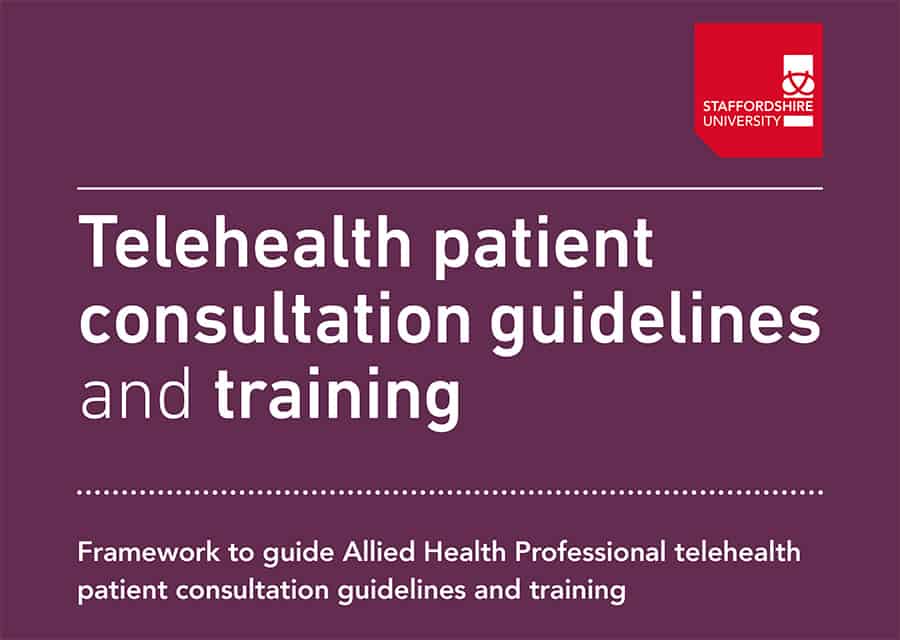New framework will help AHPs create telehealth patient consultation guidelines and training

Researchers from Staffordshire University have launched a new policy brief to assist allied health professions (AHPs) with the creation of telehealth patient consultation guidelines and training.
Entitled ‘Telehealth patient consultation guidelines and training’, the framework has been created in the context that telehealth has become a “mainstream modality” of healthcare delivery.
It follows from research conducted by a team at Staffordshire University, which found that many AHPs are not adequately supported in the delivery of remote patient consultations.
The document states: “More comprehensive guidelines and training programmes are needed to support the effective implementation and long-term sustainability of telehealth in AHP services in a post-pandemic world.”
The policy brief, based on research findings, presents the implementation, financial and technical considerations that should be considered while designing telehealth guidelines and, consequently, implementing telehealth consultations within a clinical service. In addition, it also presents a list of considerations for staff training, to ensure AHPs have the skills needed to provide telehealth consultations.
Professor Nachi Chockalingam, Director of the Centre for Biomechanics and Rehabilitation Technologies at Staffordshire University, commented: “This work is a shining example of research that has successfully translated into real-world policy. All 14 AHP professional bodies have endorsed our work and they have been involved as stakeholders. We believe many of them will now adopt this framework which they can adapt for their use.
“It’s essential that all our healthcare professionals are equipped with the necessary skills and knowledge to provide high-quality care to patients remotely.”
The COVID-19 pandemic saw an unprecedented expansion of telehealth with a shift to remote patient consultations across the professions, which includes prosthetics and orthotists, physiotherapists, and occupational therapists.
However, a study, led by Staffordshire University and part funded by Public Health England via the British Association of Prosthetics and Orthotics (BAPO), demonstrated that current telehealth guidelines and training programmes for AHPs were not sufficiently comprehensive and lack information on key telehealth aspects.
Lead Researcher Dr Aoife Healy commented: “Based on our research, we recommend that telehealth guidelines and training should include information on patient privacy, data security, and the use of technology which is consistent across the professions.”
The framework highlights the importance of investing in telehealth infrastructure and training to ensure that AHPs can continue to provide high-quality care to patients, even in the face of a pandemic.
Developed in partnership with AHPs, the framework has been presented to professional body representatives, managers, and policymakers in the UK and overseas.
Dr Nicky Eddison, a practising orthotist and a key member of the team, added: “Telehealth training should be mandatory for all AHPs, alongside access to ongoing professional development opportunities.”
The framework makes recommendations across three areas for AHPs when developing telehealth guidelines and training:
- Implementation considerations – These include factors influencing clinical decision-making in remote consultations; organisational infrastructures, which comprise human elements (e.g., service users, their families, and telehealth healthcare teams); routines (e.g., documentation and checklist); and formal processes.
- Financial considerations – These incorporate costs, reimbursement, and insurance coverage.
- Technical considerations – These incorporate considerations of how technical infrastructures, including both telehealth material (e.g., physical and virtual space characteristics) and immaterial features (e.g., training), influence key issues such as privacy, risk, and safety when consulting remotely.
For example, when an AHP is delivering a telehealth consultation, one implementation consideration might be for AHPs to outline what the “red flags” are for when a face-to-face consultation is more appropriate. A financial consideration might be the cost of setting up and maintaining a telehealth consultation service, i.e. equipment, training, and administration. One technical consideration might be room requirements for the AHP to deliver an effective telehealth consultation, such as a private and quiet room or good lighting.
Another example is staff training for telehealth consultations. Implementation considerations include assessing a patient’s suitability for telehealth, ensuring personalised care, dealing with emergencies during a telehealth consultation, and more. Technical considerations are how to use the software and hardware required for conducting telehealth consultations.
Read the framework in full here.

